The Peter Thiel Files, File I
Part 1 of a multi-part investigation into the ideology, influence, and empire of a man reshaping tech, politics, and power.
Peter Thiel has helped shape the modern world, but most people couldn’t pick him out of a lineup. He’s a shadow figure, really.. rarely in front of the camera, yet almost certainly behind something you know of or use.
He has many faces but the most well known? Well.. he co-founded PayPal with Elon Musk, helped to fund Facebook, and played a role in Palantir which is one of the most powerful surveillance companies on earth. He’s a billionaire who funds far-right candidates, dreams of billionaire governed city-states at sea, and believes democracy is incompatible with freedom. He’s invested millions into dystopian anti-aging ventures like the Methuselah Foundation and parabiosis experiments involving transfusions of young blood, in pursuit of radical life extension and even technological immortality.
The deeper you dig, the more it feels like lore: a ghost behind the infrastructure of modern life, quietly shaping it to his will. He prefers to influence from the shadows, and the shadows are where he thrives. So, to understand the man he became, you have to look at the world that shaped him.
Peter Thiel was born in Frankfurt, West Germany, in 1967 to Klaus and Susanne Thiel. When he was just a year old, the family immigrated to the United States, and later moved across continents as his father, a chemical engineer, took jobs in apartheid South Africa and Namibia. As a boy, Thiel attended a German-language elementary school in Swakopmund, Namibia, a town built by German colonists, where Nazi memorabilia was still sold in shops and Hitler’s birthday was celebrated well into the 1980s. His classmates remember the school as cold and militaristic. Uniforms were mandatory. Corporal punishment was routine. Discipline wasn’t just enforced, no, it was idealized.
Later, in apartheid-era South Africa, Thiel was enrolled in a whites-only prep school, where he was taught that order mattered more than justice, and white hierarchy was natural.. At home, things were no softer. His parents were deeply religious and fanatically conservative.
Friends were never invited over. Emotion wasn’t modeled. Classmates described him as joyless, robotic, a boy who never laughed. He was bullied relentlessly for his small frame, for his perfectionism, for his "effeminate" mannerisms. He took refuge in systems: chess, fantasy novels, and strict personal rituals.
Stanford University
Peter Thiel arrived at Stanford in 1985 with a mindset already shaped by competitiveness and a sense of superiority. He earned a 4.0 GPA and made sure others knew he believed his was better than theirs because it had more A+ grades.
First, Peter majored in philosophy, where he became deeply enamored by the works of Leo Strauss.
Strauss taught that the greatest philosophers throughout history often hid their real ideas beneath the surface of their writing. That the truth should be layered beneath more simple or politically safe arguments. Why? Because he believed that some truths were too dangerous for the general public, and should only be understood by a small, wise elite. Of course, it is easy to speculate that Peter considered himself the wise elite in this scenario.
After finishing his philosophy degree in 1989, Thiel stayed at Stanford to earn a Juris Doctor (J.D.) in 1992. During law school, he joined the Federalist Society, a conservative legal organization dedicated to reshaping American law by interpreting the Constitution as the Founding Fathers supposedly intended.
See, the Federalist Society began in the 1980s as a club for right-wing law students but has since turned into a judicial kingmaker machine. By the time Donald Trump entered the White House, nearly every federal judge he appointed, over 85% of them, had direct ties to the Federalist Society. It wasn’t just background influence, either.
A man named Leonard Leo, one of the Society’s most powerful behind-the-scenes operatives, personally helped vet and handpick Supreme Court nominees. That’s how we got Gorsuch, Kavanaugh, and Amy Coney Barrett. Clarence Thomas and Samuel Alito? Also affiliated. They had all expense paid trips on Leonard Leo’s dime.
One former Stanford classmate, Julie Lythcott-Haims, recalled an especially chilling interaction during their freshman year.
She had approached Thiel to ask about a rumor she’d heard.. that he defended South African apartheid. According to her account, Thiel looked her in the eye and said, “Apartheid is a sound economic system. Moral issues are irrelevant.” As a young Black woman at Stanford in the 1980s, she remembered the moment as one of fear and alienation.
He showed no emotion, no acknowledgment of the pain or stakes involved in what he was saying. “The chill up my spine didn’t go away that day,” she wrote. “If anything, my fear was now greater knowing I was living with someone who seemed indifferent to human suffering.”
Another classmate, Megan Maxwell, independently recalled a similar experience. In a separate conversation, Thiel told her that governments shouldn't be judged by morality and that “morality and government shouldn’t be connected.” Maxwell was stunned that Thiel could attempt to justify apartheid to two Black women in separate conversations, without any sense of audience or consequence.
Though Thiel denies supporting apartheid, he did not dispute that such conversations may have happened.. only that they might have been “misremembered.” The memories of those who spoke with him directly remain sharp, and consistent.
As Lythcott-Haims wrote years later, “It wasn’t remarkable to him. It was unremarkable. To him.”
The Stanford Review
In 1987, Thiel co-founded The Stanford Review, a conservative student newspaper meant to push back against what he saw as liberal groupthink on campus. The paper quickly became known for inflammatory content.
Two of the most controversial writers at The Stanford Review were David Sacks and Keith Rabois, both close to Thiel. Sacks defended statutory rape in print, while Rabois shouted homophobic slurs outside a faculty member’s home. Both later became players in Thiel’s PayPal network and longtime allies in his rise to power.
Many editions of The Review from that era are now missing from Stanford’s archives, rumored to have been deliberately removed to protect reputations.
Rejection, Rage, Reinvention
Peter believed in meritocracy, in the value of intellectual dominance, and above all, in the correctness of his own superiority. Everything he had achieved at Stanford pointed toward one destination: a clerkship at the Supreme Court. That was the prize. That was the peak. Then the letter came, and it wasn’t an invitation. It was a door slamming shut.
He didn’t get the clerkship. Not even an interview.
For someone like Thiel, this wasn’t just a missed opportunity.. it was a fundamental rupture in the narrative of who he believed he was. Thiel didn’t just want to succeed within elite institutions; he wanted their recognition. Their approval was supposed to affirm what he already knew: that he was smarter, sharper, and more serious than those around him.
Yet, when it came time for the highest level of the legal world to weigh his worth, it passed him over without a second thought. That kind of blow doesn’t land softly in someone who has built their identity on being exceptional but rather than try again, or consider what might have gone wrong, Thiel turned inward, and then outward, with a new kind of clarity.
To Peter, he didn’t lack the qualifications. He didn’t lack the intellect. So the problem had to be the system itself. The court, the institutions, the gatekeepers… they weren’t rejecting him because he wasn’t good enough. They were rejecting him because they were rigged, misguided, undeserving of their own power.
So, after leaving Stanford, Thiel did not stay in law for long. He clerked briefly on the Eleventh Circuit Court of Appeals, and took a prestigious job at Sullivan & Cromwell in New York. This was one of the most powerful corporate law firms in the country.
He hated it. He lasted just over seven months before walking away. He once described the work as "soul-crushing," devoid of creativity, and beneath someone with real vision. The firm, like the court, represented the polished machinery of an establishment he no longer believed in.
What came next wasn’t some triumphant leap into tech. It was something colder. A retreat. Not from ambition, but from the kinds of rooms where ambition was expected to come with deference. Thiel tried finance for a while. He flirted with journalism. He launched a small capital management firm.
Nothing stuck, not really.. until 1998, when he met Max Levchin, a young programmer with a vague idea about transferring money between PalmPilots.
It didn’t matter that the idea was half-baked. Thiel didn’t care about the code. What he saw was the architecture of escape. The internet wasn’t just a new industry. It was a place where he could build a parallel world. One where no court could reject him. No undeserving elite could shut the door. One where money and power could flow without permission.
This wasn’t a story of rejection followed by resilience. It was rejection followed by something darker: reinvention. He didn’t try to prove the court wrong. He didn’t try to win their favor. He walked away. He stopped asking to be let in. If the gatekeepers didn’t want him, he would become the one holding the keys. The one writing the rules and this time, no one else would get a vote.
The PayPal Mafia
See, it didn’t begin as PayPal. Not exactly.
In 1998, Thiel co-founded Confinity with Max Levchin and Luke Nosek with the goal of transferring money between PalmPilots. However, they really started building was a digital payments platform.. an early concept of money that could move without banks, without borders, without oversight. Thiel didn’t just see a product. He saw the beginnings of an escape hatch from the traditional economy.
Around the same time, another startup appeared with the same goal. It was called X.com (No, not Twitter, the original X), and it belonged to Elon Musk. Musk had the same dream, but with a different flavor. Flashier, messier. More vision than structure. A power struggle followed. The two companies were forced into a merger, not unlike two rival kingdoms fusing through an arranged marriage. It was uneasy. Temporary. But it worked. Confinity and X.com joined forces, and out of that uneasy alliance came PayPal.
Thiel emerged as the power behind the curtain. When Musk was ousted in a boardroom coup, Thiel took over as CEO. Under him, PayPal didn’t just grow. It hardened. Its user base exploded, and Thiel’s fingerprints were everywhere.
He didn’t choose executives based on traditional resumes. He chose them based on ideology. Loyalty. Sharpness. Willingness to break things. Many of them had come through The Stanford Review, the conservative college newspaper Thiel had founded over a decade earlier. David Sacks had been one of its most provocative writers, penning inflammatory pieces defending a student who pled no contest to statutory rape and mocking campus feminists. Keith Rabois, another Review alum, had made his name screaming homophobic slurs outside a professor’s home under the guise of “free speech.” These were not youthful missteps. They were auditions.
At PayPal, Thiel assembled them like generals.
David Sacks became COO.
Rabois an executive vice president.
Reid Hoffman, though not part of the Review, shared the contrarian ethos and brought his own network of influence.
Elon Musk remained part of the constellation, though often at odds with Thiel.
They were all brash, libertarian, and deeply skeptical of government. Nearly all of them upon leaving PayPal, would go on to build or bankroll the pillars of the next internet: YouTube, LinkedIn, Yelp, Palantir, SpaceX.
They called them the PayPal Mafia, but it wasn’t a joke.
These men were not just building companies. They were building a parallel infrastructure of capital and control, a Silicon Valley shadow state driven by surveillance, speed, and private power.
What began as a startup became a syndicate. What began as a payment system became the architecture of something larger and men writing it into reality were the same ones who had spent their college years railing against feminism, multiculturalism, and “softness” in the pages of Thiel’s student paper. Now they weren’t just writing opinions.
They were writing code and the system they were designing wasn’t just financial. It was political. It was cultural, and it was just getting started.
When finished here, you can find file two here
The lore of Peter Thiel is long, tangled, and deeply disturbing. It can't be told in a single post, so this will be a multi-part series that breaks down his history, beliefs, and the influence he quietly wields across tech, politics, and global power structures.
If this caught your interest, feel free to subscribe. You can sign up for free, or choose a monthly payment if you’d like to support this work. Either way, my writing will always remain free to read, with no paywalls. This work isn’t about profit. It’s about telling the truth. Billionaires like Thiel shape the world we live in, often without public scrutiny or consent. We deserve to know who they are, where they came from, and what they’re building.

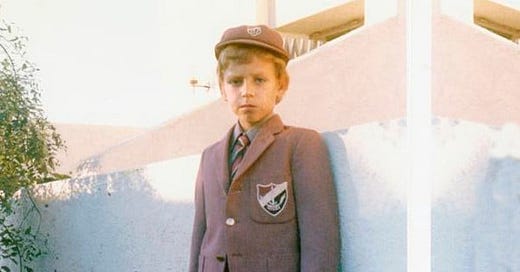





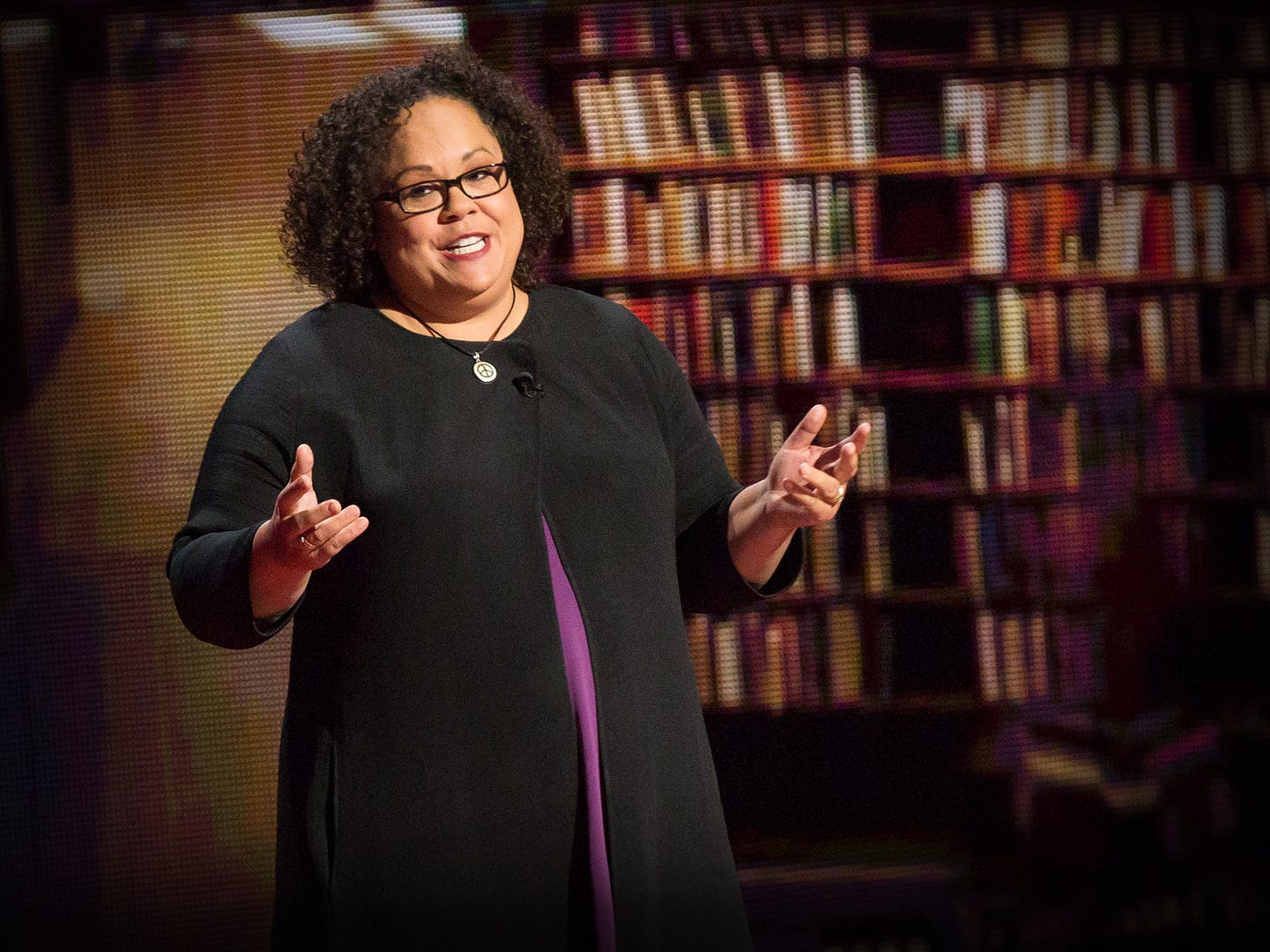
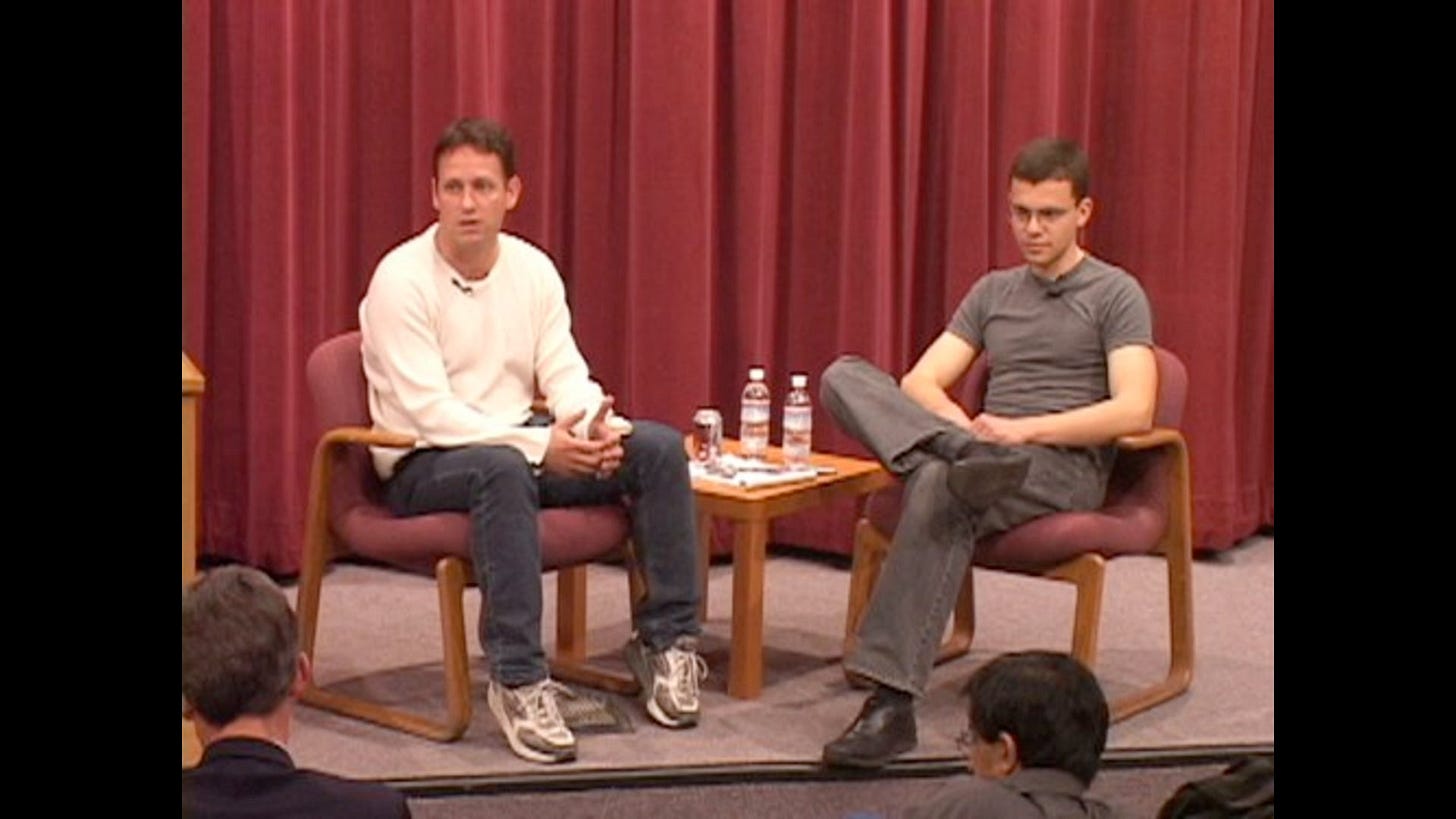
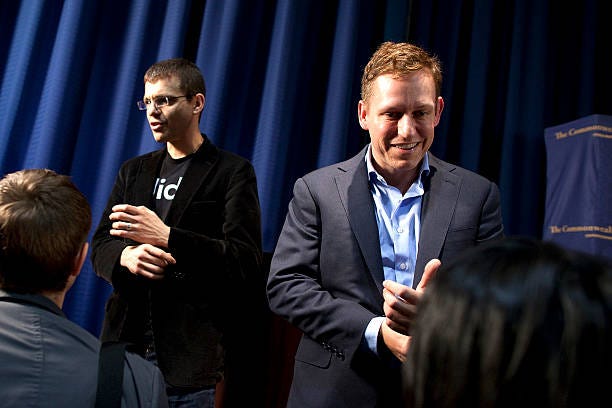

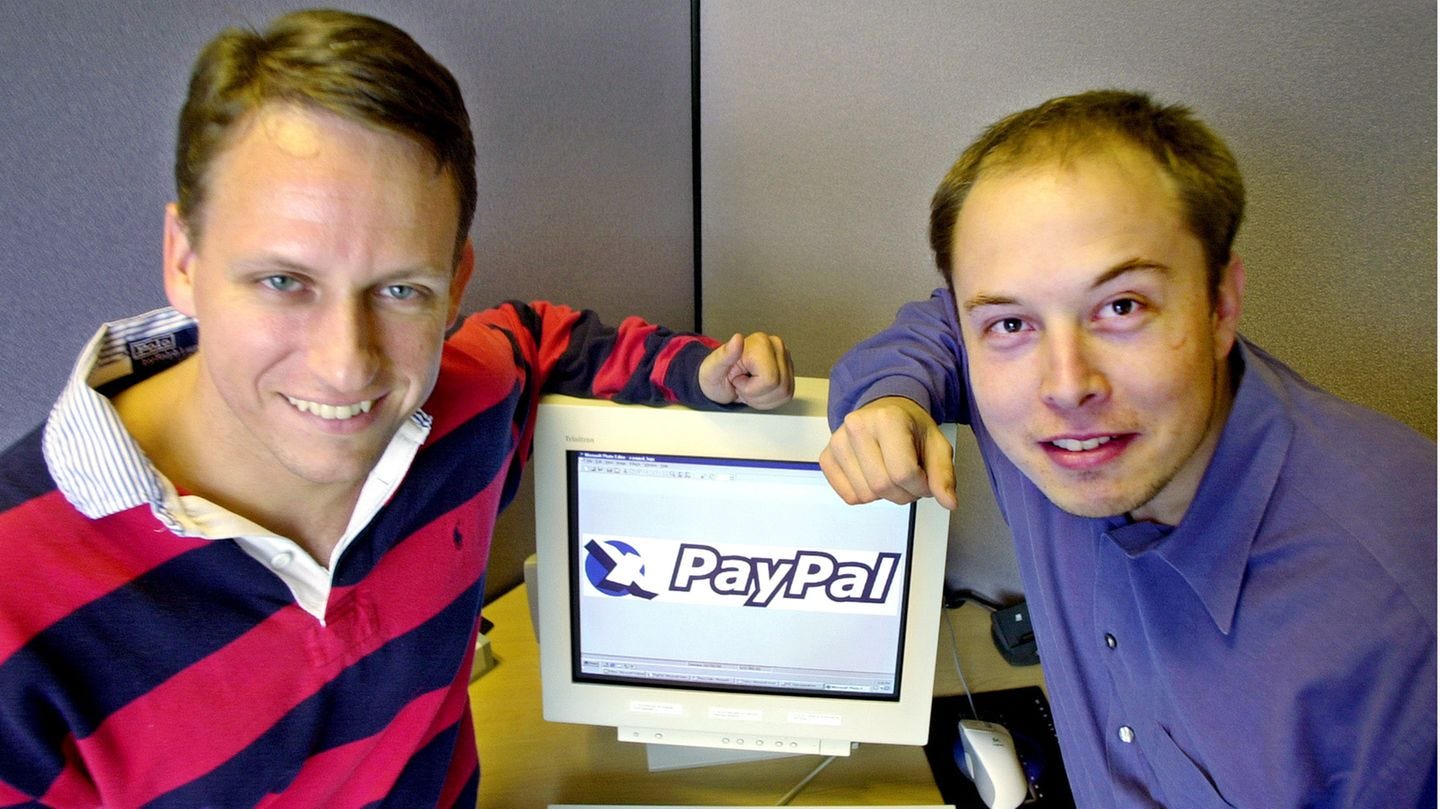

The more I read about these guys the more I’m sure they think Drump is a useful idiot.
The freedom Thiel considers his is one that means he can do anything he wants but lesser beings aren’t invited. He is gay and I don’t know how to integrate that part into the obvious homophobia of some of his best buddies. It is hilarious to see a picture of Elon with a very receding hairline that he has obviously had fixed with all his gazillion dollars.